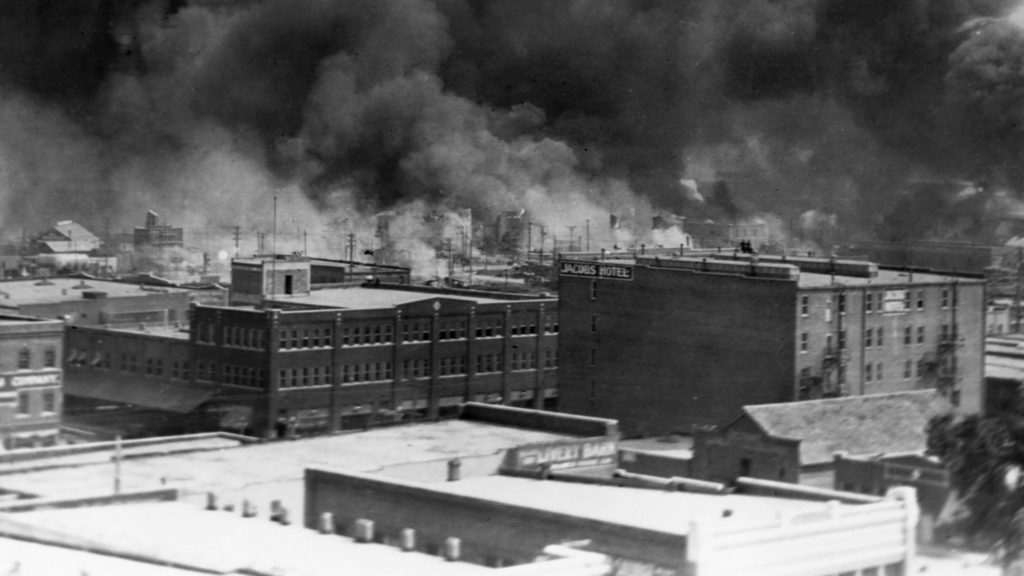While members of the Greenwood community of Tulsa were forcefully interned, the City, County, and Chamber pushed for and enacted changes in fire regulations and zoning laws in Greenwood that illegally deprived Greenwood residents of their property. The goal of this unlawful scheme was to move the Black residents of Greenwood further north, away from the White-owned Tulsa downtown district.

According to the then Tulsa Director of the Red Cross, Maurice Willows, the City and Chamber made a concerted effort to create “public sentiment which would force the negros to rebuild in a section somewhere outside the city limits.”[1]
In what appears to be one of the Public Welfare Board’s first official actions, it appointed the Tulsa Real Estate Exchange and charged it with appraising the properties that were burned in the Massacre. Among those appointed to the exchange was W. Tate Brady—a known member of the Ku Klux Klan and one of the deputized armed White men who terrorized Greenwood on the night of the Massacre.
On June 3, 1921—hardly two days after the Massacre had ended—the Tulsa World reported that around noon on the day before, the Exchange considered “the practicability of converting the burned area into an industrial section with the result that the negro district would be removed to . . . the northeast [North Tulsa].”[2]
The Tribune published the Exchange’s written proposal:
We believe that the vacant lots with proper railroad facilities will bring enough money to enable the negroes to build in a more removed section. We further believe that the two races being divided by an industrial section will draw more distinctive lines and thereby eliminate the inter-mingling of the lower elements of the two races, which in our opinion is the root of the evil which should not exist.[3]
Many Greenwood residents lived on the sites of the internment camps for over a year in squalid conditions while awaiting reconstruction.
In the days and weeks following the Massacre, City and County officials and local White businessmen, including members of the Chamber, engaged in unreasonable, unwarranted, and/or unlawful acts and courses of conduct designed to prevent reconstruction of the Greenwood neighborhood and community. The zoning change, eventually declared unlawful by the Oklahoma Supreme Court, made reconstruction efforts prohibitively costly for Greenwood residents. The Oklahoma Supreme Court struck down the zoning ordinance in response to an expensive and time-consuming lawsuit brought by Massacre survivors that further drained their limited resources for rebuilding.
Even still, the ordinance caused a months-long delay in the rebuilding efforts, which left survivors of the Massacre to live in makeshift tents as their shelter into the winter, subjecting them to cold, filth, and disease for up to a year after the Massacre. The Red Cross, which was active in relief efforts from June 1, 1921 through December 31 of that same year, erected tents to house some of the refugees in the former residential section of Greenwood. Other residents improvised, building shanties and structures on the tamped down ashes where their homes once stood. The Red Cross also offered to pay for the train tickets of those who wanted to leave Tulsa.[4] Many made that choice, while those who stayed were eager to rebuild.
[1] Rob Hower,1921 TULSA RACE RIOT: THE AMERICAN RED CROSS-ANGELS OF MERCY, 183, 1998..Maurice Willows, Disaster Relief Report, in Hower, Angels of Mercy, 145.
[2] Plan to Move Negroes Into New District, Tulsa Tribune, June 3, 1921, at .
[3] To Appraise All Loss by Negroes, Tulsa World, June 3, 1921, at 1, https://chroniclingamerica.loc.gov/lccn/sn85042345/1921-06-03/ed-1/seq-1/.
[4] Ellsworth, Death in a Promised Land, locs. 1233-1238

